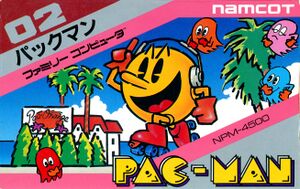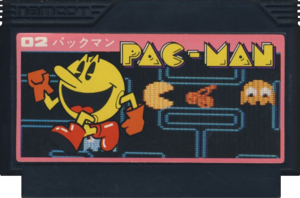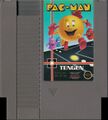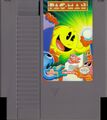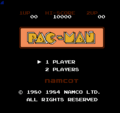Pac-Man
パックマン
Pac-Man is a maze runner game developed and published by Namco. Originally an arcade game, it was released on the Family Computer on November 2, 1984. It was released three times on the Nintendo Entertainment System, firstly an officially licensed version by Tengen on October 11, 1988, then a second, unlicensed version by Tengen in 1989, and finally a version by Namco on November 19, 1993. Additionally, a version for the Famicom Disk System was released as a budget title via Family Computer Disk Writer kiosks. Unlike the arcade version, Pac-Man uses the name of the western release, which would be carried forward through its sequels and spin offs.
Gameplay
The player controls a yellow circle (or puck) named "Pac-Man". Pac-Man can move in 4 directions, and cannot stop unless they are blocked by a wall. Pac-Man spawns in a blue maze full of dots. This maze have a passage that wraps around to the other side of the screen on the left and right. The maze is full of dots that Pac-Man automatically eats, all dots need to be eaten to finish the stage. 4 ghosts with different movement patterns occupy this maze, all hunting down Pac-Man. To counteract these ghosts, Pac-Man can collect power pellets, that temporarily allow Pac-Man to eat the ghosts. There are also fruits that appear on the stage that grant bonus points. Each stage becomes more difficult than the last as ghosts become faster and power pellets time grows shorter. In the original arcade version, the game enters a "Kill Screen" state at stage 256.
Other Ports
Pac-Man and variants of Pac-Man have received numerous rereleases, especially as part of Namco Museum. The Famicom version is not the first home port of the game. In America, the Atari 2600 version was released first in 1982 with much fanfare. Despite being of infamously[needs source] poor quality, it became one of the top sellers for the system.
Gallery
- Pac-Man FC Cartridge.jpg
The cartridge for the Famicom version.
